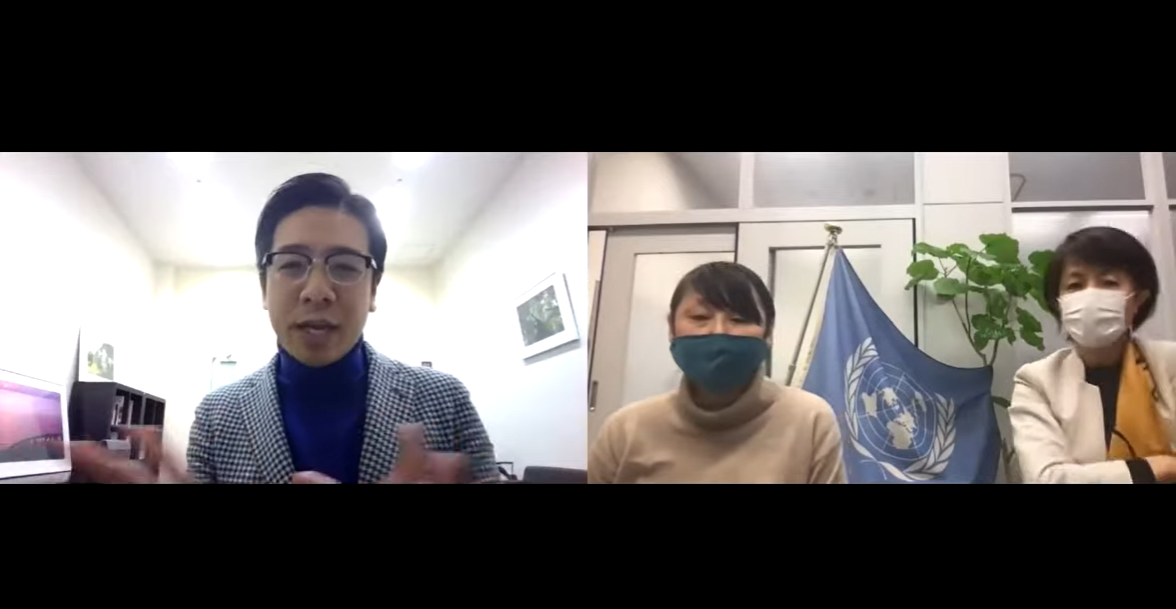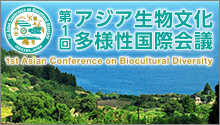According to the principle of “realising a city where people can enjoy working and living”, we need to “construct a city that is friendly for the visually-disabled” and “support people who want to work in adequate jobs”. To what extent have these objectives been satisfied? Yumiko Hayashi, President of “AUWA for Visually Disabled People’s Working” and who also has a vision disability, talked about her experience.
She had been working for an IT company as a system engineer for 20 years. She became partially sighted 14 years ago; when she consulted her boss, she was advised to leave the company for personal reasons. She was a single parent at the time, so she could not resign. She refused to leave and acquired a physical disability certificate. She was transferred to a different section. Having difficulties in doing an unfamiliar job without any support, her health and eye condition became worse, and she took a leave of absence.
She consulted Ishikawa Polytechnic School for the Disabled to find an appropriate job, but she could not find any jobs for visually disabled people. Therefore, she decided to enter Ishikawa Prefectural School for the Blind to obtain a national license as a masseur (for acupuncture, moxibustion and massage). She worried about life during her three years of school attendance, but she could not find any options other than going to the school. When she attended a school meeting for parents of blind people, she was shocked to know that system engineer is one of the jobs recommended for blind people. She felt very regretful, thinking that she would not have left her job if she had known the fact. This feeling has become the driving force for her current activities.
Although she graduated from the school and acquired the license, she could not find employment. Therefore, she studied as a clinical trainee in order to open a clinic. In 2012, she opened Ladies’ Acupuncture and Moxibustion Clinic OLIVE. After that, it took three years to become able to live and work independently. Nine years passed from the time she lost partial vision to finally becoming independent.
While working at the clinic, she established “AUWA for Visually Disabled People’s Working” in 2017 in order to help build a society where all people, including disabled people, can enjoy working actively.
What are visually disabled people? What kind of jobs can they do?
The Law on Welfare for People with Physical Disabilities prescribes that visually impaired people are divided into two categories: people with visual strength defects and people with visual field defects. There are about 300,000 visually impaired people in Japan. The number of people with acquired visual impairment grows larger in accordance with age. The number of people with low vision who are not provided with a physical disability certificate is said to be three times those with a certificate. These people are not receiving sufficient welfare service, which is a serious problem.
Jobs recommended for visually impaired people other than acupuncture, moxibustion and massage therapists include health workers for companies, teachers, civil servants, musicians and IT workers; however, there are few visually impaired people who are engaged in these jobs in Ishikawa.
Working conditions of visually impaired people in Japan
We would like to focus on the problems specific to Kanazawa City and Ishikawa Prefecture among the many problems in working conditions of visually impaired people.
- A lack of supporters who understand appropriate jobs for visually impaired people
- A lack of places for vocational training other than schools for the blind, resulting in difficulties in making contact with companies
- A lack of support for people with low vision, including visual rehabilitation
- A significant shortage in ophthalmic clinics for people with low vision
There are large regional differences in approaches to these problems. We need to create an environment that supports the employment of visually impaired people in our region.
There was a great change in the circumstances in January 2021. The Vocational Development Center for the Blind and Low Vision in Japan Inc. in Yotsuya, Tokyo, commenced online vocation training for visually impaired people in Japan. I immediately applied for the training and became the first student of the OA basic course (PC training using audio reading software). Being able to receive different types of vocational training such as this, which is not possible in Ishikawa, represented great progress.
I hope that all people become able to live comfortably in society whether they have disabilities or not. The number of people who start to suffer from visual impairment increases with age; therefore, it is said that there will be more people with serious short-sighted visual disabilities in the future. I hope that all of you will regard the problem as your own and endeavor to build a society where visually impaired people can live comfortably.
Supporting people who cannot work even though they want to
Next, Junichi Okuyama talked about his experience starting a business, and the present condition of the employment of disabled people.
I joined a recruitment company and started working for the Kanazawa branch. Then, I realised that there were very few offers of employment and recruiting agencies for disabled people. Thus, in 2012, I established Visst Inc. to help realise the wish of disabled people to work. We started providing employment support in Ishikawa, and then expanded the service into Toyama and Kanagawa. We are now expanding our business into various fields, such as after-school care involving early career education for elementary, junior high and high school students, and development support projects for preschool children. In our group, we also have companies for supporting the employment of people who experience difficulties working.
Working might become easier if you make some changes in your environment or ways of thinking, and if you come to feel comfortable in working, there will be no barrier. Barriers for working are divided into “individual models”, which should be overcome by individuals, and “social models”, which need to be solved by society. For instance, people in wheelchairs become able to move easily if steps and gaps are eliminated. There are many things in our environment that society can change to eliminate barriers.
Solving accumulated problems
Next, UNU-IAS OUIK office manager Ms. Nagai participated and the three people had a talk session, answering questions from the audience and Ms. Nagai. Many concrete ideas were presented to solve problems, such as a project for matching social welfare offices and companies in the Kanazawa SDGs platform in order to raise the employment rate of disabled people.
The seminar recording is available on OUIK’s Youtube channel:




